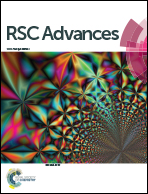One-dimensional nanofiber architecture of an anatase TiO2–carbon composite with improved sodium storage performance†
Abstract
Titanium-based oxides have been considered promising anode materials for rechargeable sodium (Na)-ion batteries (NIBs); however, the slow reaction kinetics of TiO2 due to its low electrical conductivity remains a critical problem to be addressed for its practical application in NIBs. Here, we report one-dimensional (1D) TiO2–C composite nanofibers for use as an anode for NIBs, which were fabricated via an electrospinning technique combined with optimized heat-treatment. The TiO2–C composite nanofibers are composed of tiny anatase TiO2 nanocrystals surrounded by and/or embedded in the conducting carbon matrix. When tested in an electrochemical Na cell, the TiO2–C nanofiber electrode retained a high charge capacity of 140 mA h g−1, even after 100 cycles at a current density of 60 mA g−1, and it exhibited excellent rate-capability (105 mA h g−1 at 3 A g−1), proving its feasibility as an NIB anode. The superior Na storage performance of the nanofiber anode is mainly attributed to the unique composite architecture, that is, a large number of active sites per volume due to the high aspect ratios and short lengths for Na transport through 1D nanofibers and TiO2 nanocrystals as well as highly conducting electron paths.


 Please wait while we load your content...
Please wait while we load your content...